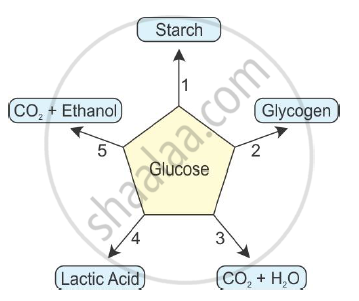Advertisements
Advertisements
प्रश्न
How does aerobic respiration differ from anaerobic respiration?
उत्तर
The difference between aerobic and anaerobic respiration are -
| Aerobic Respiration | Anaerobic respiration |
| Takes place in the presence of Oxygen | Takes place in the absence of Oxygen |
| Carbon dioxide and water are the end products. | Carbon dioxide and lactic acid /ethano lare the end products |
| More efficient in energy production | Less efficient in energy production |
| Takes place in animals and plants | Takes place in unicellular organisms |
APPEARS IN
संबंधित प्रश्न
Given below are the end products of different reactions involving glucose.

Write the reaction number in front of the following:
(i) Anaerobic reaction =
(ii) Reaction in the human muscles =
(iii) Aerobic respiration =
(iv) Reaction in the plant cells =
(v) Reaction in the liver
Name one substance which is produced in anaerobic respiration by an organism but not in aerobic respiration.
Name the areas in a woody stem through which respiratory exchange of gases takes place.
Name an animal which depends on simple diffusion of gases for breathing.
What is the other name of wind-pipe?
Name the type of respiration in which the end product is:
C2H5OH and CO2
Give one example where such a respiration can occur.
Describe the process of respiration in Amoeba. State whether it is anaerobic respiration or aerobic respiration.
State the three common features of all the respiratory organs like skin, gills and lungs.
How are oxygen and carbon dioxide exchanged in our body during respiration?
Why is diffusion insufficient to meet the oxygen requirements of large multicellular organisms like humans?
During respiration, the exchange of gases takes place in:
Lack of oxygen in muscles often leads to cramps in the legs of sprinters. This is due to the conversion of pyruvate to:
During the deficiency of oxygen in tissues of human beings, pyruvic acid is converted into lactic acid in:
A, B and C are three living organisms. The organism A is a unicellullar fungus which can live without air. It is used in the commercial production of an organic compound P from molasses. The organism B is a unicellular animal which lives in water and feeds and moves by using pseudopodia. It breathes through an organelle Q. The organism C is a tiny animal which acts as a carrier of malarial parasite. It breathes and respires through a kind of tiny holes R and air-tubes S in its body.
(a) What are organisms (i) A (ii) B, and (iii) C?
(b) Name (i) P (ii) Q (iii) R, and (iv) S.
(c) Which organism/organisms undergo aerobic respiration?
(d) Which organism/organisms undergo anaerobic respiration?
Out of xylem and phloem, which one carries materials upwards as well as downwards?
It has been found that people living in very high mountains have many more red corpuscles in their blood than people living in plains. Which one of the following best accounts for this phenomenon?
Name the body structure concerned with the given functional activity:
Combines with the oxygen in the lungs.
____________ is the maximum amount of air that the lungs can hold after a maximum forceful inspiration.
The partial pressure of oxygen of blood in pulmonary capillaries is i ______ mrnHg while in alveolar air it is ii ______ mmHg.
Visit a local doctor. Learn about the harmful effects of smoking. You can also collect material on this topic from other sources. You can seek help of your teacher or parents. Find out the percentage of people of your area who smoke. If you have a smoker in your family, confront him with the material that you have collected.
